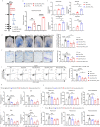Gut microbiota facilitate chronic spontaneous urticaria
- PMID: 38168034
- PMCID: PMC10762022
- DOI: 10.1038/s41467-023-44373-x
Gut microbiota facilitate chronic spontaneous urticaria
Abstract
Chronic spontaneous urticaria (CSU) comes with gut dysbiosis, but its relevance remains elusive. Here we use metagenomics sequencing and short-chain fatty acids metabolomics and assess the effects of human CSU fecal microbial transplantation, Klebsiella pneumoniae, Roseburia hominis, and metabolites in vivo. CSU gut microbiota displays low diversity and short-chain fatty acids production, but high gut Klebsiella pneumoniae levels, negatively correlates with blood short-chain fatty acids levels and links to high disease activity. Blood lipopolysaccharide levels are elevated, link to rapid disease relapse, and high gut levels of conditional pathogenic bacteria. CSU microbiome transfer and Klebsiella pneumoniae transplantation facilitate IgE-mediated mast cell(MC)-driven skin inflammatory responses and increase intestinal permeability and blood lipopolysaccharide accumulation in recipient mice. Transplantation of Roseburia hominis and caproate administration protect recipient mice from MC-driven skin inflammation. Here, we show gut microbiome alterations, in CSU, may reduce short-chain fatty acids and increase lipopolysaccharide levels, respectively, and facilitate MC-driven skin inflammation.
© 2024. The Author(s).
Conflict of interest statement
M.Ma is or recently was a speaker and/or advisor for and/or has received research funding from Astria, Allakos, Alnylam, Amgen, Aralez, ArgenX, AstraZeneca, BioCryst, Blueprint, Celldex, Centogene, CSL Behring, Dyax, FAES, Genentech, GIInnovation, GSK, Innate Pharma, Kalvista, Kyowa Kirin, Leo Pharma, Lilly, Menarini, Moxie, Novartis, Pfizer, Pharming, Pharvaris, Roche, Sanofi/Regeneron, Shire/Takeda, Third Harmonic Bio, UCB, and Uriach. All other authors declare no competing interests.
Figures







Similar articles
-
Abnormalities in Gut Microbiota and Metabolism in Patients With Chronic Spontaneous Urticaria.Front Immunol. 2021 Oct 15;12:691304. doi: 10.3389/fimmu.2021.691304. eCollection 2021. Front Immunol. 2021. PMID: 34721374 Free PMC article.
-
Gut Microbiome Alterations and Functional Prediction in Chronic Spontaneous Urticaria Patients.J Microbiol Biotechnol. 2021 May 28;31(5):747-755. doi: 10.4014/jmb.2012.12022. J Microbiol Biotechnol. 2021. PMID: 33746191 Free PMC article.
-
Gut Microbiome and Serum Metabolome Analyses Identify Unsaturated Fatty Acids and Butanoate Metabolism Induced by Gut Microbiota in Patients With Chronic Spontaneous Urticaria.Front Cell Infect Microbiol. 2020 Feb 21;10:24. doi: 10.3389/fcimb.2020.00024. eCollection 2020. Front Cell Infect Microbiol. 2020. PMID: 32154184 Free PMC article.
-
Bacterial Metabolites: A Link between Gut Microbiota and Dermatological Diseases.Int J Mol Sci. 2023 Feb 9;24(4):3494. doi: 10.3390/ijms24043494. Int J Mol Sci. 2023. PMID: 36834904 Free PMC article. Review.
-
Gut Microbiome Composition in Patients with Chronic Urticaria: A Review of Current Evidence and Data.Life (Basel). 2023 Jan 4;13(1):152. doi: 10.3390/life13010152. Life (Basel). 2023. PMID: 36676101 Free PMC article. Review.
Cited by
-
Skin Microbiota, Immune Cell, and Skin Fibrosis: A Comprehensive Mendelian Randomization Study.Biomedicines. 2024 Oct 21;12(10):2409. doi: 10.3390/biomedicines12102409. Biomedicines. 2024. PMID: 39457721 Free PMC article.
-
Atopic Dermatitis and Psoriasis: Similarities and Differences in Metabolism and Microbiome.Clin Rev Allergy Immunol. 2024 Jun;66(3):294-315. doi: 10.1007/s12016-024-08995-3. Epub 2024 Jul 2. Clin Rev Allergy Immunol. 2024. PMID: 38954264 Review.
-
Gut microbial alteration in chronic spontaneous urticaria unresponsive to second generation antihistamines and its correlation with disease characteristics- a cross-sectional case-control study.Clin Transl Allergy. 2025 Jan;15(1):e70027. doi: 10.1002/clt2.70027. Clin Transl Allergy. 2025. PMID: 39809718 Free PMC article.
-
Vitiligo: are microbes to blame?Biosci Microbiota Food Health. 2025;44(1):16-25. doi: 10.12938/bmfh.2024-051. Epub 2024 Aug 30. Biosci Microbiota Food Health. 2025. PMID: 39764486 Free PMC article. Review.
-
The Interplay of Cross-Organ Immune Regulation in Inflammation and Cancer.MedComm (2020). 2025 Jun 15;6(7):e70249. doi: 10.1002/mco2.70249. eCollection 2025 Jul. MedComm (2020). 2025. PMID: 40529611 Free PMC article. Review.
References
Publication types
MeSH terms
Substances
Supplementary concepts
Grants and funding
- 81974476/National Natural Science Foundation of China (National Science Foundation of China)
- 82173424/National Natural Science Foundation of China (National Science Foundation of China)
- 82073458/National Natural Science Foundation of China (National Science Foundation of China)
- 81830096/National Natural Science Foundation of China (National Science Foundation of China)
LinkOut - more resources
Full Text Sources
Molecular Biology Databases

